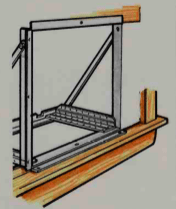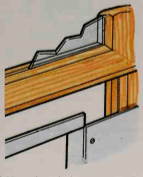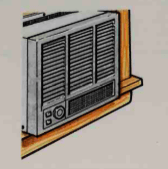Contents
Air Conditioning Maintenance
There are two basic types of air-conditioning systems for the home — central air conditioning, which cools the entire house and is usually operated through the furnace ductwork; and room units, which cool only the room in which they’re located.
If you’re planning on installing air conditioning, keep in mind that a room unit for every room of the house will be more expensive to operate than central air conditioning. However, installation costs of central air will
be quite high if there’s no usable ductwork in your house and a separate ducting system needs to be installed.
The efficiency of any air-conditioning system is measured in BTUs (British Thermal Units) or tonnage. A BTU is the amount of heat removed in an hour. Tonnage is the comparative cooling effect of melting a ton of ice in an hour. There are 12,000 BTUs in 1 ton. Although air conditioners are sometimes rated by horsepower, avoid this as a measurement, because there can be a wide range in BTUs in two units rated at 1 horsepower. And it’s the BTU measurement you need to determine the cooling capacity for your air conditioner. Generally, 12,000 BTUs are the equivalent of 46m2 (500ft2) in a home.
Room Air Conditioners
A room air conditioner is designed to cool only the room in which it is situated. The units are usually fastened to the windowsill, but can also be installed in a sleeve that fits through the wall.
In these units, warm air passes over the cooling coil and loses its heat. With the help of a fan or blower, the conditioned air is circulated in the room. The heat that was removed from the air forces the cold liquid refrigerant in the evaporator to vaporize The vaporized refrigerant is transported to the compressor, which compresses the vapor and raises its temperature to a higher degree than the outside air. By then the refrigerant is hot and moves to the condenser, where the vapor liquifies and gives up the room heat to the outside air. The hot refrigerant then passes through a restrictor, which lowers its temperature and liquifies the refrigerant, which then re-enters the evaporator to repeat the cycle.
When buying a room air conditioner, check for thermostats and automatic fan controls so that cooling can be regulated. Also make sure there’s a built-in compressor shut-off for protection against overheated motor windings, and make sure there’s an effective method of condensation disposal.
If you’re installing the unit in a bedroom, you might want to check noise and vibration levels as well.
Many smaller air-conditioning units come with a do-it-yourself installation kit, which you and a helper can follow to ensure proper installation.
Window units are usually fastened to the window by mounting frames with a rubber gasket forced tight around the entire unit to prevent air leakage to the outside.
Units can also be mounted through the wall. Find the studs on the inside wall and, with accurate frame-opening measurements, cut the wallboard away. With a drill and long drill bit, cut through to the outside wall to indicate the four corners of your cut. Remove the outside wall and insulation. Saw off the portion of the stud that falls in the middle of your opening and insert a preassembled wood frame into the opening. Attach the unit housing, caulking around the outside edges to prevent water or air seepage. Apply any finishing woodwork, then insert the air conditioner.
Small units can be handled by the 120-volt house current, but larger units may need a 240-volt outlet.
A time-delay fuse should be used in the circuit that contains your unit, since there is usually a great surge of power when the unit starts up, which could cause an overload on a regular fuse.
INSTALLING AN AIR CONDITIONER

To install a window air conditioner, first assemble the frame.

Attach it to the mounting frame in the center of the window.

Add weatherstripping to prevent air leaks around the joins.

Slide the air conditioner into place and seal with the supplied rubber gasket.
Central Air Conditioning
Central air-conditioning systems are less expensive to operate, run more quietly ana offer better cooling than individual room units. There are two types of systems available.
The single package system has all the components in one package. It can be installed indoors; however, the noise and vibration make outdoor installation preferable. If installed outdoors, a connecting duct needs to be installed through the wall into the unit at one end and the existing ductwork at the other.
The most popular central air system is the split system, where the condenser and compressor are located outdoors to minimize noise and vibration and are connected by copper tubing to the cooling coil located on the furnace, where the furnace blower and ducts are used to circulate the air through the house.
Most air conditioners need a special line to the fuse box to accommodate a voltage higher than regular household voltage; however, regardless of requirements, a separate line should be run between the fuse box and the air conditioner to eliminate overloading of household circuits.
Always check to make sure your installation complies with local building codes.
CENTRAL AIR CONDITIONING

A split system central air conditioning system is the most popular system because the compressor unit is located outdoors for quieter operation. The compressor is connected to the furnace by copper pipes, and the furnace ductwork and blower are used to cool the house.
Electronic Air Cleaners
Electronic air cleaners, not to be confused with table-top models that serve a similar but more confined use, are attached to your furnace to eliminate dust, smoke and pollen from the air. They make housework easier by cutting down on the dust, and they also provide cleaner air for allergy sufferers.
When particles enter the cleaner, they receive a positive charge and are attracted to negatively charged collecting plates, where they remain.
The movement of air through the clearer is constant and air flow is provided by the furnace blower.
The only maintenance necessary for these units is regular cleaning of the collector plates.
